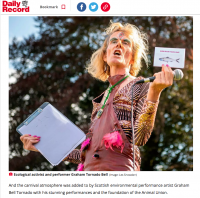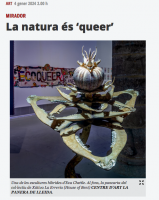PRESS and TV
Newspaper Articles (digital)
Most articles are in Spanish and can be consulted on the Spanish page. Some have been translated and are available online here.
Dumfries Nithraid river festival to return on August 24 (Daily Record Aug 12 and 30)
Two articles about the festival, including images, mentioned my residency in Dumfries with EcoArt and the performance at Nithraid. They can be seen here and here
La natura és ‘queer’ (El Punt Avui, Jan 2024)
Review of the Queer Ecologies exhibition which includes a text on our intervention- “The act of sewing, traditionally relegated to women in the privacy of the home, mutates into a public act of resistance in this proposal by the collective La Erreria (House of Bent) from Xàtiva, who sewed a banner with the slogan Ecoqueerplanet with scraps of recycled fabric. In 2022, they carried it in the LGTBI+ Pride demonstration in Valencia. The piece has multiple authors because it was conceived as a collaborative and itinerant project. And it has lost none of its validity, in moments like the current one, when culture in Valencia is in the hands of an extremist right-wing bullfighter.” ( our translation) Original article here
El ‘Territory Trans’ de Graham Bell Tornado en Fantastik Lab (Makma 2022)
Review of the Trans Territory exhibition (in spanish) here
TranSisters: Clara, Rampova & Me (Cultur Plaza, 2022)
Article about my play based on my relationship with the artist Rampova and their cabaret group Ploma 2. It can be read here
La Erreria reivindica... (Makma, 2021)
Article about La Erreria (House of Bent) installation in the exhibition De Reüll 1990-2020. It can be read here
Natural Hysteria (Levante, 2020)
Article about my doctoral thesis in the newspaper Levante
Ecogénero siglo XXI (El Levante, 2019)
Article about Ecogender and the 10th anniversary exhibition of the Erreria (House of Bent) here
La casa de los errores y aciertos ( "The House of Errors and Successes" El Levante, 2010)
Article about the "Erreria (House of Bent) which tells the story of how we opened the basement of our house as an outside and queer gallery, expanding into the concept of a house-museum (based on places like the John Soames museum in London, the Gustave Moreau museum in Paris or the Josep Segrelles museum in Albaida, all museums based in houses) giving guided tours and organising exhibitions and events in the provincial town of Xàtiva.
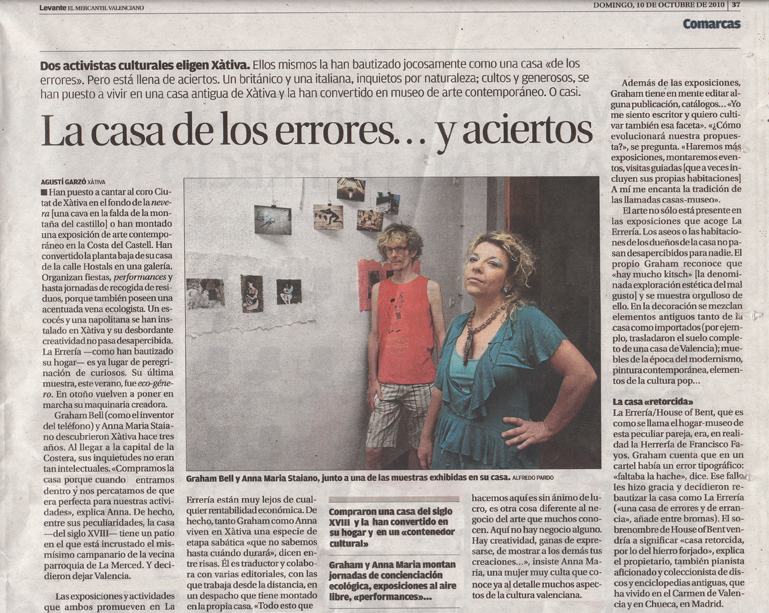
Los Trastornaós -el flamenco punk que llegó de Escocia ("Los Trastornados- the flamenco punk who came from Scotland" El Mundo, 2005)
Article about the musical group Los Trastornados which fused flamenco and punk. My lyrics- in Spanish and English- combined with their live interpretation was an attempt to capture the viscerality of these musical styles. In the 3 years I studied with flamenco guitarists I learned various hardcore flamenco "palos"(styles).

La policia multa una crucifixión publica ("The police fine a public crucifixion", Levante, 2007)
Article about the action carried out by members of the cast of "Comedia sin titulo" an unfinished theatre piece by Federico Garcia Lorca. I was invited to work with a flamenco dancer on the final "missing" scene and devised a dialogue between the dancer and the "worker" my character (who is assasinated in the play).
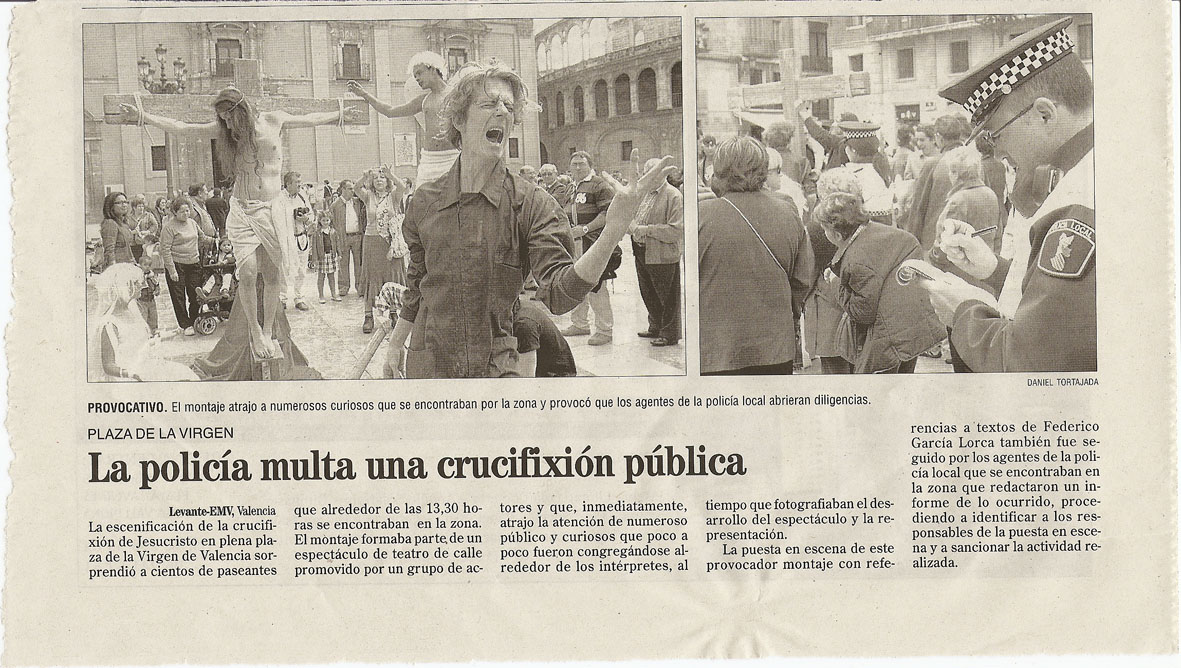
This is a translated extract from the interview by Jesus Garcia Civico for El Canibaal literary magazine
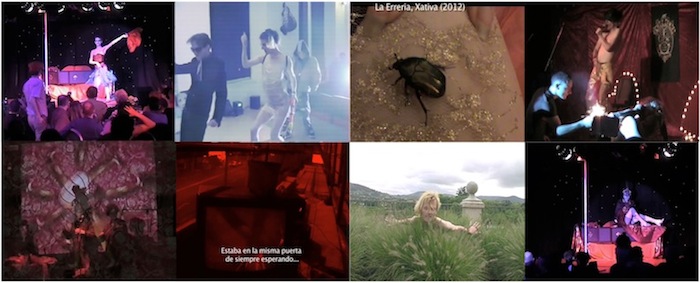
Canibaal: How would you define your work for those who do not know it?
GBT: Definitions are complicated- it depends on the day. In English the term "renaissance man " is used about someone who can´t be compartmentalized. I believe that I am more of a "renaissance trans" because my practice is queer and political.
It takes a multitude of forms not only because it reflects my insatiable curiosity, but also because it reflects the insecurity of a transgender existence, we have to be multi-skilled to survive in today's society. So I make music, videos and altered books like the Reciciclopedia, a project that reviews the history of the book in queer and feminist terms.
Then there is the better known part of my work, my performances, or what I call "rituals" in which the symbolic power of transformation plays an important role. Rituals satisfy an atavistic human need and their repetition helps build the identity of a community. I think it is essential for queers, feminists, and ecologists to construct new rituals and ceremonies that reflect our values and help build an egalitarian society especially at a time like this, in which it seems fundamentalists have captured the symbolic imagery of our society.
Another aspect of my performances is what I call antitainment because they combine social commitment with popular forms of entertainment such as cabaret, varieté and pop videos, forms which are generally looked down upon in the serious art world for being frivolous. But as the song says: "a spoonful of sugar helps the medicine go down."
Canibaal: We are interested in the interpretation that can be made of your work in a critical (or biological) viewpoint of political organization. What does this consist of?
GBT: Maybe it's because I studied biophysics and genetics at university in England at a time when student politics were very volatile. Thatcher was not only attacking students rights but also those of workers, homosexuals, everybody. It was there that I began to relate biological organization to social organization. The cellular mechanisms of the body compose a system of interrelated processes in a complex equilibrium, which is the result of the slow process of evolution. On the other hand democracy is the result of a series of struggles throughout history to establish a balance between the people and their rulers. All elements of an ecosystem have to function as a set so that the total of the system is kept in balance. Current neoliberal politics and the practices of the consumer society based on the continuous growth of the economy and the population attack this balance and threaten it in an atrocious way. Often the media trivialize or turn these subjects into a form of entertainment in order to convert their viewers into passive subjects. Today utopian promises might seem obsolete however politicians and religious leaders continue to promote discourses that support the industrial machine, corporations and banks.
I believe that in the field of the arts our struggle lies in the criticism and dissemination of anti-establishment information using tools such as satire, irony and metaphor. I have written and performed several political manifestos and commercials for non-existent products. For example in various performances and in the video Jackie TV is Selling Retro-Modernisme I played with the double meaning of the word clash in English. I wrote a speech which went something like this: clashes between unions and governments will be abolished and replaced by clashes between beige and cream, clashes between ecologists and corporations will be abolished and replaced by clashes between brown and khaki.
Then I carried out a series of coronations, participatory ceremonies in which I crown everyone, in a action which criticizes the pillars of our society - the army, the church, the state - and also the whole concept of the “nation state”. Queers have no country, we´re a transnational community without frontiers.
Canibaal: As you know, at Canibaal we believe in the autonomy of art, and we were struck by one of your recent actions which at the time passed us by but which seems to sum up that idea of art very well- Bejewelled Voluptuary made in collaboration with the fabulous creator of glitter and jewels, Anna Maria Staiano, your partner in La Erreria. What did it consist of?
GBT: Things which shine like beetles, sequins, pearls and jewels have always fascinated me for the quality of light they reflect. Many beetles make their shells from a material that reflects light and gives them an iridescent quality. For many people insects are just bugs or pests and when they can they squash them. They are the scum, the queers of the animal kingdom and fascinate me because their life cycle includes metamorphosis, that is, their bodies change completely. For me they are a metaphor for queer, showing that nothing is fixed: we can adapt, change and evolve towards a beauty that is not just merely superficial.
Bejewelled Voluptuary is an ongoing project where I explore my kitsch and decadent side in a tribute to the camp and underground film pioneers who have inspired me: Jack Smith, Kenneth Anger and, in this case, James Bidgood director of the film Pink Narcissus. The project began one day when a iridescent beetle flew through the window of our house-museum The Erreria and landed on an artificial orchid, perhaps attracted by its colour and form. We decided to try and film it crawling over my naked body covered with jewels. However it was difficult to convince the beetle, which we baptised Clarissa, to collaborate in the film shoot, so the video remained unfinished and we decided to film more another day in a forest or other natural landscape.
We did another try-out on the nudist beach of Perello. I undressed and lay down on the seashore and Anna Maria began to cover me with jewels as people walked along the beach. An old lady stopped to stare at us for a long time and finally came over and asked what was the purpose of what we were doing.
Anna Maria didn´t know what to answer, because the question made no sense to her. It was a mis / encounter between two planes of existence so different and almost incomprehensible to each other. After several failed attempts at communication the lady asked if it was a medical treatment for circulation or rheumatism. Anna Maria replied that the action did not have a medical purpose and the lady asked in surprise: "Then why do you do it?"
And of course that is a relevant question because what is the use of art? Does it have a practical utility? Anna Maria simply replied "He looks very handsome covered in jewels, don´t you think?"
Canibaal: You also collaborated on the project Impure with Anna Maria, is there any news on that?
GBT: Impure is the latest publication of La Erreria (House of Bent) cultural association that promotes queer and outsider art. Impure is a self-published book and we continue to promote it along with other projects with a mini tour that will take us first to Barcelona where we are super excited to present it at La Canibal bookstore and then in Madame Jasmine with one of our performative fashion shows. Then we go to Bilbao where we´ll present it at Hika Ateneo, then we´ll be showing a selection of our short films at the Zinegoak LGBTQ Film Festival. We´ll also hold the opening ceremony of our seventh Post Industrial Natural Queer (P.I.N.Q.) Park while we´re there.
The Erreria is flaming!
(originally published online at Canibaal )
TV appearances
Metropolis: Ecologias Queer (RTVE2, 2024)
This documentary, aired on the main art programme on national Spanish tv includes an interview where I talk about my ecoqueer practice and works in the collective exhibition Queer Ecologies: Naturally Subversive Aberrations. Watch here
Destino España (RTVE1, 2011)
I was also featured as part of a documentary series Destino España about foreigners living in Spain and carried out a performance as transgender tour guide of the Erreria house museum and the cultural scene in Valencia. It was so successful it was repeated in the "best of" the series and a rival tv station based a report on it, "sending me up". Don´t think they realised the game I was playing! Only available in Spanish
Eco-Gender /EcoGenero (Localia, 2010)
A local tv station filmed a 40 minute report on the Ecogender exhibition. An edited extract (with English subtitles) can be seen here.
Graham Bell LIVES! (Canal Nou, 2010)
A report about my work and La Erreria (House of Bent) was broadcast on controversial local tv channel Canal Nou, now closed after a central government intervention! Like many spaniards the reporters were amazed at my name (since for them the inventor of the telephone - Alexander Graham Bell- is very famous) hence the title of the report.
The Spark (Border TV, 1998)
My first TV appearance was as part of this documentary series which featured a special on the artists community at Orchardton where I was living. As part of the documentary the makers agreed to help produce and screen my short film us-in-the-future.
Digital Sex (Channel 4, 2000)
I was interviewed with stripper and performance artist "Mouse" in this series which included footage of our performance of "Tits" (song by my group Arch) at the ICA.
Artículos en la prensa
La natura és ‘queer’ (El Punt Avui, Ene 2024)
Reseña de la exposición Ecologías Queer que incluye un texto sobre nuestra intervención. Se puede leer aqui
El ‘Territory Trans’ de Graham Bell Tornado en Fantastik Lab (MAKMA 2022)
Articulo sobre la exposición Trans Territory aqui
TranSisters: Clara Rampova & Me (culturplaza, 2022)
Artículo sobre esta obra de teatro estrenado en el Carme Teatre como parte del festival Vociferio aqui
La Erreria reivindica... (2021) artículo sobre nuestra instalación en la exposición De Reüll en la revista Makma
Natural Hysteria (2020) - artículo sobre mi tesis doctoral en el periodico Levante
Ecogénero siglo XXI (2019) artículo sobre Ecogénero y la exposición del decimo aniversario de la Erreria en el periodico El Levante
Entrevista a Graham Bell Tornado... (2017) artículo sobre mi práctica por Jesus Garcia Civico en la revista literaria El Canibaal
La casa de los errores... (Levante,2010)
Artículo en el periódico sobre el proyecto La Erreria (House of Bent), que narra la historia de cómo abrimos el sótano de nuestra casa como una galería de arte outsider y queer.

La policia multa una crucifixión... (Levante, 2007)
Artículo sobre la acción que realizamos en la Plaza de la Virgen, el reparto del espectáculo teatral "Comedia sin titulo" obra inacabada de Federico García Lorca. Me invitaron a trabajar con un bailarín de flamenco en este obra para realizar la escena final "desaparecida" e ideé un diálogo entre el bailarín y mi personaje en la obra el trabajador (que muere, asesinado en la obra).

Los Trastorna´os el flamenco punk... (2005) artículo sobre el grupo musical que mezclaba el flamenco y el punk en el periodico El Mundo

Reportajes en Televisión
Metropolis: Ecologias Queer (RTVE2, 2024)
Este documental, emitido en el principal programa de arte de la televisión nacional española, incluye una entrevista donde hablo sobre mi práctica ecoqueer y mis trabajos en la exposición colectiva Ecologías queer. Aberraciones naturalmente subversivas.Se puede ver aqui
Destino España (RTVE1, 2011)
Un documental sobre extranjeros que viven en España. Realicé una actuación como guía transgénero de la casa museo de La Erreria y la escena cultural del barrio del Carmen en Valencia. El reportaje se repitió en el "mejor de" la serie y una emisora de televisión rival basó un informe satirico sobre mi. No creo que se dieron cuenta del juego que estaba jugando!
Destino España
Un cortometraje que incluye excerptos de un reportaje de la television local sobre la exposición de Eco-Género.
TV Localia
En Connexió (Canal Nou, 2010)
Reportaje sobre La Erreria (House of Bent) y mi obra por el programa Canal Nou
En un informativo local, los periodistas se maravillaron de mi nombre de "famoso" y pusieron como titular (el inventor del telefono) "¡Graham Bell vive!".
The Spark (Border TV, 1998)
Mi primera aparición en televisión fue en la television local de Escocia como parte de este documental, en un capitulo dedicado a la comunidad de artistas en Orchardton, donde yo estaba viviendo. Como parte del documental los creadores acordaron ayudar a producir y proyectar mi cortometraje "us-in-the-future".
Digital Sex (Channel 4, 2000)
Fui entrevistado con el artista de striptease y performance "Mouse" y mostraron nuestro performance de "Tits" (canción de mi grupo Arch) en el Instituto de Arte Contemporaneo de Londres.

